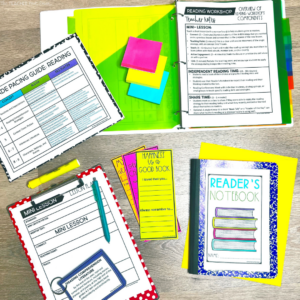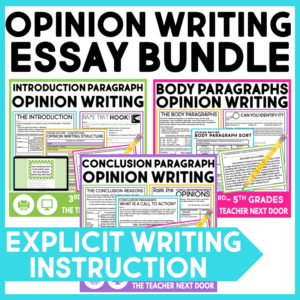
Life without a Reading Pacing Guide was hectic. Lesson planning for reading took me so much longer than any other subject.
You might be thinking that that’s normal, right? After all, our Reading block is the longest block of the day. Some may argue that it’s also the most important block of the day too.
However, not only was lesson planning taking me forever, but my team and I were always scrambling to decide what we were teaching next week and with what resources.
If you’ve ever been in that situation before, I will bet that your reading program was less than stellar. (To put it lightly.)
When you’re stuck with a reading program that is missing major components, is designed poorly, or doesn’t hit the standards, it makes your teacher-life a total disaster.
Without quality reading resources, we get stuck piecemealing different units together and finding things to fill the holes all over the internet.
I have good news, though. I found a way to make lesson planning for reading EASIER. Using a Pacing Guide is the KEY to your success.
With these simple steps, you can take back your time and make lesson planning a smooth-running machine. The best part? It’s all free!
Why Lesson Planning Is So Difficult
When we are teaching, we have no less than hundreds of things on our to-do lists each and every week.
Think about it. You’re consciously creating to-do lists about:
- What lessons to teach
- What homework pages to assign
- Who to send absent work home with
- Which copies to make
- Whose parents to call
- What meetings are happening during your plan time
- The emails you need to respond to
- And hundreds of other teacher-related items
You’re also subconsciously creating to-do lists for:
- Which students to scaffold for
- Which student needs major behavior support during lessons
- When you’re going to take a bathroom break for yourself
- What folder you need to bring with you when you drop your kids off at music because you’ll swing by the office and drop it off in the secretary’s mailbox
- And So. Many. More
There are so many things to remember to do each day that it’s no wonder that lesson planning can feel like a huge chore.
How Zooming Out with a Pacing Guide Can Help You Zoom In
It’s hard to see the forest for the trees when you’re in the thick of the school year.
Using a Yearlong Pacing Guide helps take the guesswork out of what comes next.
To do this, you’ll need to look at your entire school year. Here are some things to look for and make note of:
- Beginning of the year tasks (school bus evacuation drill, welcome back to school assemblies, back to school night, etc.)
- Parent-Teacher Conference date(s)
- Thanksgiving Break
- Fall Break (if applicable)
- Winter Break
- Standardized Testing (Dates & Duration)
- Spring Break
- Last Day of School
Grab your Free Pacing Guide from The Teacher Next Door and note these items on paper or the editable digital version.
Be sure to write in pencil if using a paper copy. If you’re using a digital Pacing Guide, note any dates using an identifier like a particular color or italicized font.
Deciding What Goes Where and When on Your Pacing Guide
This planning step is dependent upon your reading program and district requirements.
Planning When Adhering to School District Requirements
If abiding by district requirements, insert the concepts or reading skills you’ll tackle in the order directed by the school. Be sure to assign the amount of time you plan to spend on each skill in the column labeled weeks.
Personally, I like to simply number the weeks, but you can also add the dates if preferred.
Planning with a Reading Program or Reading Curriculum
If you do not have district requirements, but you have a reading program/reading curriculum that you are using, take a look at the order of the skills listed in the teacher’s manual.
Things to consider:
- Are the order of skills intuitive?
- Will you need to move skills around to make the program more manageable?
- Do you need to make any adjustments in order to teach the skills necessary before standardized testing in the spring?
Add the skill to your Pacing Guide in your preferred order. Again, be sure to list the duration of time using the number of weeks taught or the dates.
Planning from Scratch (No program, no curriculum, no requirements, etc.)
If you’re creating your planning guide from scratch without adhering to district or reading program requirements, you can follow The Teacher Next Door Pacing Guide! Feel free to use this pre-done Pacing Guide as a springboard for your own creation. There’s a 100% editable version for you as well.

Making Sure to Include ALL Your Reading Standards
Be sure to have a list of your state’s reading standards while developing your Pacing Guide.
It’s important to double-check that you are teaching all necessary standards throughout the year.
The Teacher Next Door Pacing Guides for Grades 3, 4, and 5 have been developed using the Common Core State Standards.
If you are not a Common Core State, don’t panic!
Surprisingly, many states have developed their reading standards from Common Core and have repackaged them with their state name.
If this is the case for you, do a quick check from the Common Core State Standards to your state standards. Chances are, they are the same or incredibly similar!
Within the FREE Pacing Guide, you’ll find a PDF file that contains the standard correlation for each week of the school year.
While planning, use a checklist to ensure that you’ve planned for every standard for your grade level.
If developing your own Pacing Guide, use The Teacher Next Door Pacing Guide as a suggestion for the amount of time to allot for each skill and make your own needed adjustments accordingly.
How-To Lesson Plan Using a Pacing Guide
(THE EASY WAY!)
Now it’s time to make lesson planning EASY!
At this point, you should have a well-thought-out Pacing Guide that covers all the essential reading skills and standards.
When lesson planning for the following week, use your Pacing Guide to determine your next steps.
First, take a look at the next week and its assigned skill.
From here, determine what you’ll need each week.
Here’s my list:
- Reading Standard
- Five Mini-Lesson Titles (can also be four if there is a day off during the week)
- Mentor Text(s) to support skill
- Anchor Chart List
- Graphic Organizer(s) List
- Formative Assessment Materials (Quick Checks, Exit Tickets, Short Assessments, etc.)
- Summative Assessment Material(s)
- Reading Centers Activities
Here’s a peek at my Mini Lesson Plan Template found in my Reading Workshop: The Complete Kit resource!
Once I know which materials I’ll need to plan for each week and for which skill, this makes my teacher life SO much easier because I’ve developed a groove.
Routines and expectations aren’t just important for students; they’re also crucial for teachers.
I love to use consistent materials and provide the same type of material with a simple shift in the reading skill.
For example, I’ll use The Teacher Next Door Reading Skills Anchor Charts each week. It makes my teacher-life SO simple.
I do a quick search for the skill that I am working on and pull the anchor chart(s) needed to support this skill.
I use this same routine every week.
The Reading Skills Anchor Charts have multiple options for every upper elementary reading standard, so I’m never left scouring the internet for Anchor Charts because I know I have them all at my fingertips.
Importantly, I am sure to use resources that allow me to build these planning habits.
Remember, setting up a list of what you’ll need every week will help make your teacher-life SO much simpler.
It’s much easier to invest in the time and resources once than sitting in front of the computer looking for new resources to support your standards each and every week.
With a solid lesson planning foundation, you can spend your time focused on the important things, not lesson plans.
Sign up for your Free Pacing Guide from The Teacher Next Door! It will be delivered directly to your inbox!

Remember, this Pacing Guide comes with everything you need to plan for the entire school year. Plus, it comes in various formats! Black and white, color, Common Core-aligned, and editable!



















